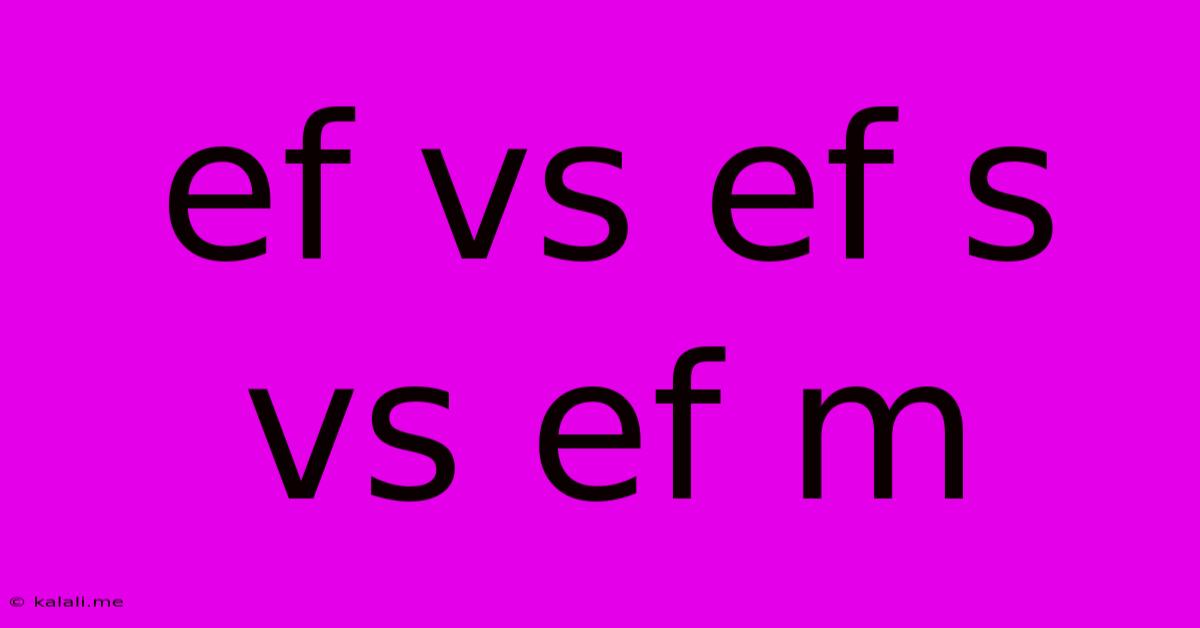Ef Vs Ef S Vs Ef M
Kalali
Jun 01, 2025 · 3 min read

Table of Contents
Canon EF, EF-S, and EF-M Lenses: Understanding the Differences
Choosing the right lens for your Canon camera can be confusing, especially with the different lens mounts: EF, EF-S, and EF-M. This article breaks down the key distinctions between these mounts, helping you choose the perfect lens for your photography needs. Understanding these differences will ensure you select a lens compatible with your camera body and maximize your photographic potential.
What are EF, EF-S, and EF-M Mounts?
These designations refer to the type of lens mount—the physical connection between the lens and the camera body. Each mount has specific characteristics that affect compatibility and image quality.
-
EF (Canon EOS): This is Canon's oldest and most versatile mount. EF lenses are compatible with nearly all Canon DSLRs and many mirrorless cameras. They offer a wide range of focal lengths and apertures, making them suitable for various photography styles.
-
EF-S (Canon EOS): EF-S lenses are designed specifically for Canon's APS-C sensor cameras (Rebel, 70D, etc.). They generally offer a wider field of view due to the smaller sensor size. Importantly, EF-S lenses are not compatible with full-frame Canon cameras.
-
EF-M (Canon EOS M): This mount is exclusive to Canon's EOS M series mirrorless cameras. EF-M lenses are generally smaller and lighter, reflecting the compact nature of the EOS M system. EF and EF-S lenses are not compatible with EF-M cameras without an adapter, and even then, you might lose some functionality.
Key Differences Summarized:
| Feature | EF | EF-S | EF-M |
|---|---|---|---|
| Sensor Compatibility | Full-frame & APS-C | APS-C only | EOS M series only |
| Size & Weight | Varies widely | Generally smaller | Smallest & Lightest |
| Image Circle | Larger | Smaller | Smaller |
| Compatibility | Most Canon cameras | APS-C Canon cameras | EOS M cameras only |
Choosing the Right Mount:
Your choice depends entirely on your camera body.
-
Full-frame Canon DSLRs or Mirrorless Cameras: You can use EF lenses.
-
APS-C Canon DSLRs: You can use both EF and EF-S lenses. EF-S lenses are generally more affordable and offer a wider field of view, while EF lenses offer greater versatility and potential resale value.
-
Canon EOS M Series Mirrorless Cameras: You must use EF-M lenses. While adapters exist to use EF and EF-S lenses, this may impact image quality and autofocus performance.
Beyond the Mount: Considering Other Factors
While the mount is crucial for compatibility, other lens specifications significantly impact your photography:
- Focal Length: Determines the field of view (wide-angle, telephoto, etc.).
- Aperture: Controls the amount of light entering the lens, influencing depth of field and image brightness.
- Image Stabilization: Reduces camera shake for sharper images, especially in low light.
- Autofocus System: Determines the speed and accuracy of autofocus.
Conclusion:
Understanding the differences between Canon's EF, EF-S, and EF-M lens mounts is vital for making informed purchasing decisions. By carefully considering your camera body and photographic needs, you can choose the lens that best suits your style and budget. Remember to always check compatibility before purchasing any lens to avoid unnecessary expenses and frustration. Happy shooting!
Latest Posts
Latest Posts
-
How Many Bearing On Each Side Of A Bycycle Hub
Jun 02, 2025
-
What Does It Mean When Your Brakes Squeak
Jun 02, 2025
-
Why Does My Car Creak When I Turn
Jun 02, 2025
-
How Loud Should Music Be Mixed In A Film
Jun 02, 2025
-
Yum Config Manager Command Not Found
Jun 02, 2025
Related Post
Thank you for visiting our website which covers about Ef Vs Ef S Vs Ef M . We hope the information provided has been useful to you. Feel free to contact us if you have any questions or need further assistance. See you next time and don't miss to bookmark.